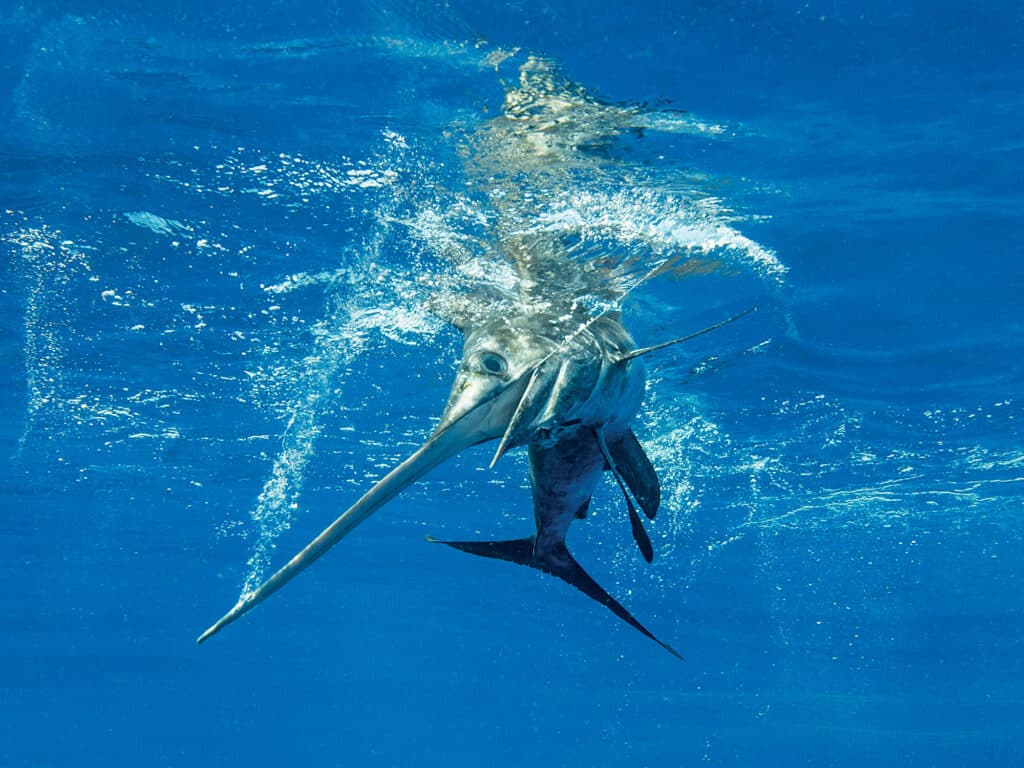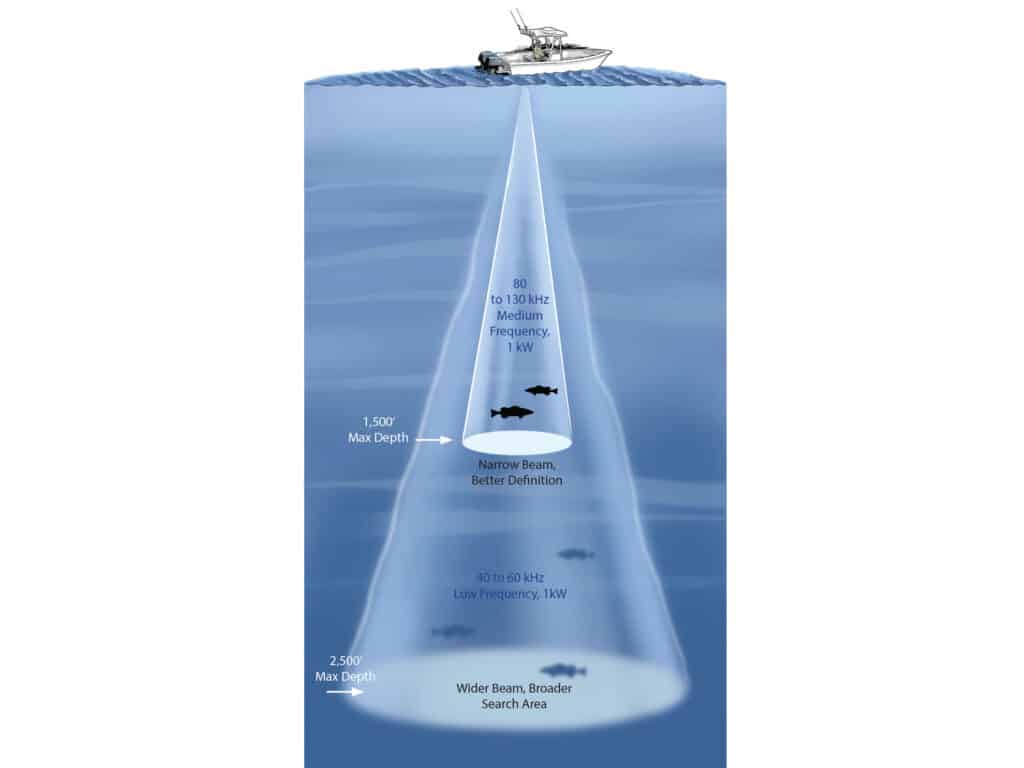Selecting the Right Transducer Frequency for Deepwater Fishing
 Daytime swordfishing calls for sonar transducer frequencies and wattage ratings that can penetrate the deepest depths.
Kevin Dodge
Daytime swordfishing calls for sonar transducer frequencies and wattage ratings that can penetrate the deepest depths.
Kevin Dodge
Today, saltwater anglers ply ever-increasing depths to catch fish. California rockfish anglers work structure lying 600 feet below the surface. Alaska fishermen target halibut in 750 feet. Deep-drop enthusiasts seek tilefish at depths of 1,500 feet or more. Daytime swordfish anglers drop baits to 2,500 feet or deeper. Whether fishing the equivalent of two football fields or a half-mile below the ocean surface, each of these fisheries requires highly specialized tackle and sonar transducers with frequencies to penetrate the abyss. Yet there is no one frequency that fits all deepwater fishing scenarios, says Craig Cushman, director of marketing for Airmar Technology Corp., the leading third-party supplier of marine transducers for brands such as Furuno, Garmin, Humminbird, Lowrance, Simrad and Raymarine.
“When an angler asks about transducers for deep water, the first question I ask is, ‘Where are you trying to catch fish?’” Cushman explains. While there are dozens of potential frequencies, it often boils down to a decision between a medium or low frequency.
Using two Airmar transducers (one for shallow water and one for deep water) to catch more fish. Frequency FundamentalsFrequency is the most important factor in deep water. So it’s critical to understand the principles of transducer frequency. Cushman references the sound of a car stereo as an analogy when explaining frequency. “When a car is playing music with the windows up, people outside might hear the bass notes, but not the treble,” Cushman points out. “That’s because bass notes broadcast at lower frequencies, which can better penetrate the car’s thick glass windows.” By the same token, lower-frequency sonar (40 to 60 kHz) can better penetrate the depths. “As the car windows are rolled down, you might pick up treble notes that could not penetrate the glass but now carry elevated octaves,” Cushman adds. Similarly, a higher-frequency sonar (130 to 310 kHz) might not penetrate the depths but can pick up fine details in shallower water.
Medium-frequency sonar (80 to 130 kHz) strikes a compromise between low and high frequencies. It can reach fairly deep and offer benefits not available in lower frequencies.
Question of DepthDefinitions of deep water vary. “While one angler views 1,000 feet as deep, another might define it as 2,500 feet,” Cushman explains. For the first angler, a medium frequency might be a better choice. For example, the medium-frequency, chirp-ready B175M model will read down to 1,500 feet and also provide strong performance at shallower ocean depths.
However, the second angler might be disappointed in the medium frequency. “The B175M might pick up a bottom echo at 2,500 feet, but not much else,” Cushman explains. “On the other hand, the low-frequency, chirp-ready B175L will produce a strong bottom reading and show fish and bait at 2,500 feet.”
Target SeparationWhen it comes to details, medium frequencies tend to show more than low frequencies, Cushman says. “If you’re looking for grouper or snapper with their chins in the rocks at 800 to 1,000 feet down, the B175M has the performance characteristics to separate these targets from the structure,” he explains.
This is largely because of a narrower beam angle that helps better define details. The B175M has a beam angle ranging from 16 to 11 degrees. The B175L, on the other hand, has a wider beam angle ranging from 32 to 21 degrees, and that does not offer the same kind of target separation.
However, a wide beam offers distinct advantages over a narrow beam, providing a wider search pattern, and that can prove helpful when looking for species such as swordfish that swim well above the bottom. In these cases, target separation is less important than the ability to view a wide swath of the water column, Cushman points out.
Read Next: Using Multi-Purpose Transducers to Find Fish
 The choice between medium- and low-frequency sonar systems hinges on the depth you fish and the target species.
Steve Sanford
More Power
The choice between medium- and low-frequency sonar systems hinges on the depth you fish and the target species.
Steve Sanford
More Power
Transmitting power represents the second-most important consideration for deep water. “All things being equal, a 1,000-watt transducer will perform better than a 600-watt transducer,” Cushman says. “It’s like turning the volume up on the car stereo—it will just boom down deeper.”
Of critical importance here is that the fish finder and transducer need to be compatible in terms of power.
Anglers who are serious about deepwater fishing gravitate to even more-powerful systems that pump out 2,000 or even 3,000 watts, Cushman observes. Yet the transducers are big.
“You need a larger, wider transducer to push energy into the water,” Cushman explains. “So, physical size increases proportionately to increases in power.”
For a comparison, Airmar’s popular low-profile, tilted-element B175 series chirp transducers mentioned earlier have faces with 14.5 square inches of surface area and pump out 1,000 watts. But Airmar’s CM599 cavity-mount chirp transducers have faces with 88.8 square inches of surface area that produce 2,000 to 3,000 watts of power.
However, many of today’s saltwater fishing boats are limited when it comes to transducer size. For example, the CM599 transducer measures 14.5 inches long and 6.13 inches wide, and requires a cavity built into the bottom of the hull. Compare that to a 3.75-inch-diameter hole needed for a round B175 series transducer.
On a 30-foot center-console boat, the sheer size, fiberglass work and expense of a CM599 transducer might not be practical or even feasible. Yet just about any saltwater fishing boat built today can accommodate one or even two of the Airmar B175 series transducers.
Ultimately, the depth range, target species, fish-finder capabilities, boat size and budget will help guide selecting the right transducer frequency for you, your boat, your fish finder and your style of deepwater fishing.
The post Selecting the Right Transducer Frequency for Deepwater Fishing appeared first on Salt Water Sportsman.
- Home
- About Us
- Write For Us / Submit Content
- Advertising And Affiliates
- Feeds And Syndication
- Contact Us
- Login
- Privacy
All Rights Reserved. Copyright , Central Coast Communications, Inc.